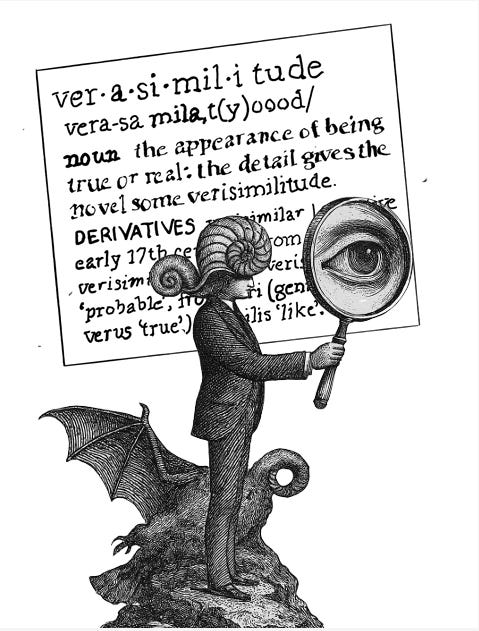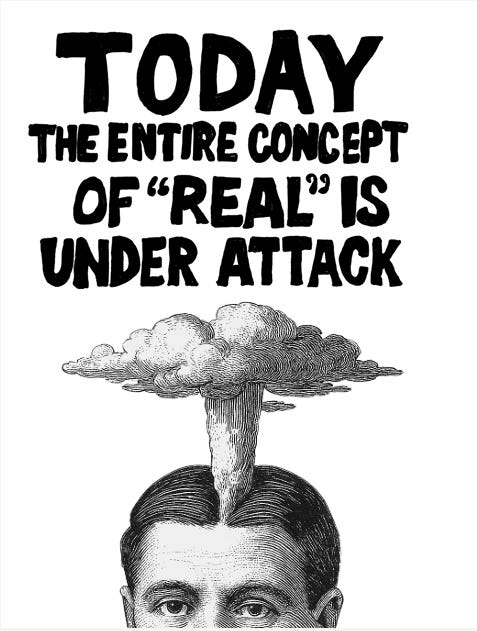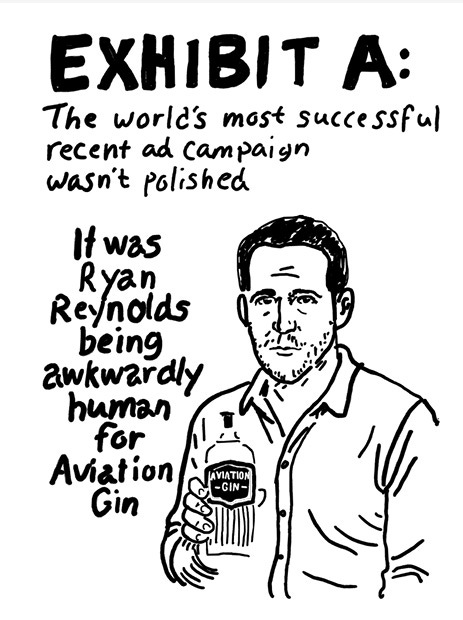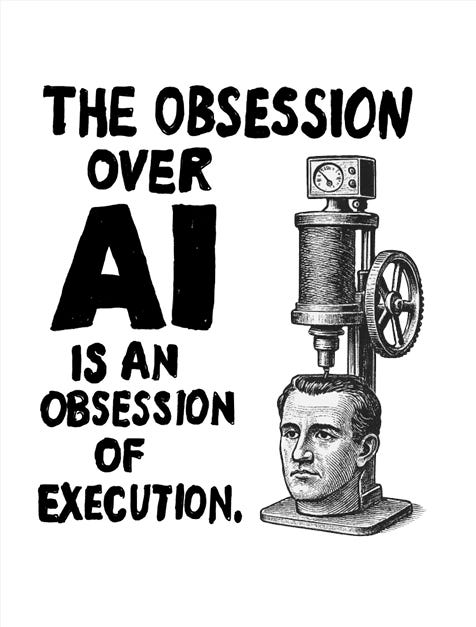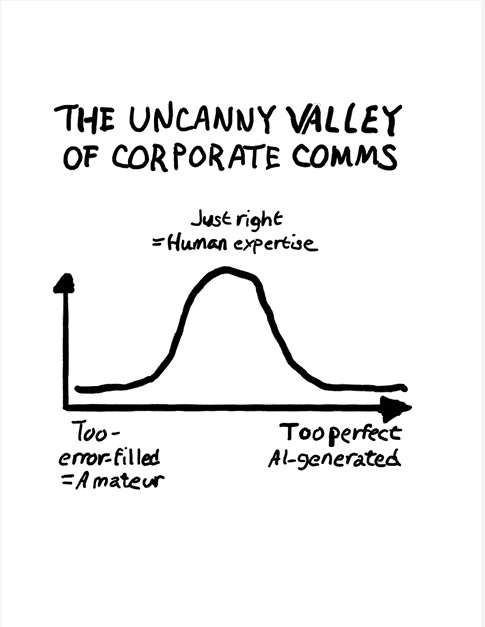Most people think perfection wins.
They're wrong.
What truly wins isn't polished perfection but strategic believability.
But I have another word for it:
”Verisimilitude."
It’s a word meant to define not the truth, but the belief in it.
And it’s the most important word in marketing.
Unfortunately, it’s also the least known.
In this newsletter, I'll break down:
What verisimilitude actually is and why it matters in marketing more now than ever
The psychological framework behind believability
The counterintuitive relationship between precision and trust
How AI has destroyed the value of perfection
A systematic approach to building content that people actually believe
Why your LinkedIn posts might be failing the believability test
The system here isn't complex. But it goes against what you've been taught about marketing, copywriting, and persuasion.
Let me explain why.
The Paradox of Perfect Content
5 months ago, I hand-drew my a LinkedIn carousel like a Zine.
Not because I wanted to look punk rock (though that's part of the experiment), but because sometimes the most disruptive thing you can do is strip away what you're hiding behind (like Canva and AI).
That's exactly what's happening with content right now. In a world where AI can generate flawless copy in seconds, perfection has become suspicious. So the polished, perfect layers we've spent our entire career striving for and building are becoming a liability.
All of a sudden, the grammar is too clean, the structure is too predictable, and the voice is too consistent.
It’s gotten so bad that most creators with years of experience often don't realize they're creating content that sounds AI-generated, even when it's not.
But people's BS detectors are becoming more sensitive than ever. And they are beginning to be able to smell manufactured content from a mile away (even if they can't articulate exactly why they're scrolling past yours).
Verisimilitude & the Science of Believability
Verisimilitude is a fancy word that essentially means the appearance of truth. This may sound like what I am talking about is lying, but it's actually the opposite. Verisimilitude is often used to describe the sense of truth accompanying a real truth.
A really good example of this is when you receive an email with a very personable subject line, only to open it and find a letter that begins "Dear Business Owner." The contents of that email may be entirely true and even relevant. However, because it came in the form of a templated letter, it doesn't quite feel genuine.
Or take the phrase "new nostalgic" and use it as a headline for an ad about dishes that resemble those from the 1950s. Now, technically speaking, a set of dishes can be both “new” and “nostalgic.” The word "nostalgic" even seems to imply that it is only refering to the past, not actually a part of it. And yet, there is just something about the words “new” and “nostalgic” put together that doesn't feel right or true.
If you ask me, verisimilitude is one of the most overlooked aspects in marketing, advertising, and copywriting. And it usually accompanies laziness and a lack of attention to detail.
But that being said, verisimilitude isn't a marketing gimmick. It's a psychological principle that governs how humans determine what's real and what's fake.
The reason for this is that we're pattern-recognition machines, and we've been programmed over thousands of years to detect when something feels "off."
This is why:
A perfectly symmetrical face feels uncanny, while a slight asymmetry feels natural
Flawless skin in photos screams "Photoshopped" while subtle imperfections signal authenticity
Round numbers like "increase sales by 50%" sound manufactured, but "47.3%" sounds measured
The principle applies to everything we consume, especially the content flooding our feeds.
The Mount Everest Effect
There's a famous story about the first surveyors of Mount Everest that illustrates this perfectly.
In 1856, they calculated the mountain's height to be exactly 29,000 feet.
But they knew something critical about human psychology:
A perfectly round number sounds like an estimate. It lacks the gritty specificity of real measurement.
So what did they do? They added 2 feet and reported the height as 29,002 feet.
Not because it was more accurate, but because it was more believable.
That's verisimilitude in action.
The Vulnerability of Perfect Claims
And it’s one of teh reasons why every time you make a claim that's too clean, too round, or too perfect, you're actually damaging your credibility.
"Our system increases productivity by 50%."
This sounds made up, even if it's technically true. Your mind immediately thinks: "Yeah, sure it does."
Compare this with:
"Our system increased productivity by 47.3% across our first 89 users."
For some reason, that feels measured, tested, even real.
The difference, and this is important, isn't in the actual value. It's in how the human mind processes specificity.
How AI Has Changed Everything
As AI gets better at generating flawless content, the strategic use of imperfection becomes your competitive advantage.
AI struggles with:
Genuine personality quirks
Strategic inconsistencies
Cultural context
Authentic emotion
The perfect amount of imperfection
The uncanny valley isn't just for robot faces anymore. It's for language, too.
Most people's content falls into this trap. It's either too messy (amateur) or too perfect (feels AI-generated). The sweet spot is human expertise polished just enough to show mastery, but human enough to be believable.
The Framework for Creating Believable Content
Here’s a systematic approach to inject some verisimilitude into everything you create (WARNING. THESE MAY CHANGE OVER TIME):
1. Specificity Over Roundness
Replace round numbers (50%) with specific ones (47.3%)
Add contextual details to claims ("increased by 32.8% during the three-month test period")
Name exact quantities rather than approximations
2. Strategic Imperfection
Vary your paragraph length drastically
Use occasional sentence fragments
Include personal asides that break the flow
Allow some natural repetition to remain
3. Humanize Your Reasoning
Always explain WHY behind offers ("We're offering 43% off because we over-ordered inventory last quarter")
Include the messy realities of business decisions
Share actual constraints you're working within
Don't be afraid to be wrong
4. Pattern Interrupts
Break your own established patterns occasionally
Use UNEXPECTED punctuation or formatting!!!
Insert micro-stories that seem slightly tangential but circle back (like the Everest story above)
The Implementation Test
Here's a framework to test if your content has verisimilitude:
If you removed your name, would friends still recognize it as yours?
Does it include details only you would notice or mention?
Are there moments of vulnerability that make you slightly uncomfortable?
Does it contain at least one element that an AI would likely filter out?
If you answered "no" to any of these, you're probably creating content that lacks verisimilitude.
The Future of Authentic Content
As creation tools get more sophisticated, the content that performs best will be the content that feels less polished.
This means that in a world of AI-perfection, being perfectly imperfect isn't just authentic; it's smart.
One Caveat
And this is important.
Just because you are trying to make your content not look like slop doesn’t mean you make it look sloppy.
So you want to deep dive into how to apply these principles to your own LinkedIn content. Apply to join my free Unforgettable Masterclasses, where I break down these frameworks in much more detail.
Here’s the link
Or you can join my LIVE weekly Unforgettable Academy sessions, where for just $100 /month, you get access to me going very in-depth with particular lessons about what it takes to stand out online, as well as well as step-by-step guide to adapting each lesson to your voice and industry, and a community of people who are fighting the same blank page battle as you.
Or you can just follow me on LinkedIn
— Justin (yes, this is really my email) Oberman



